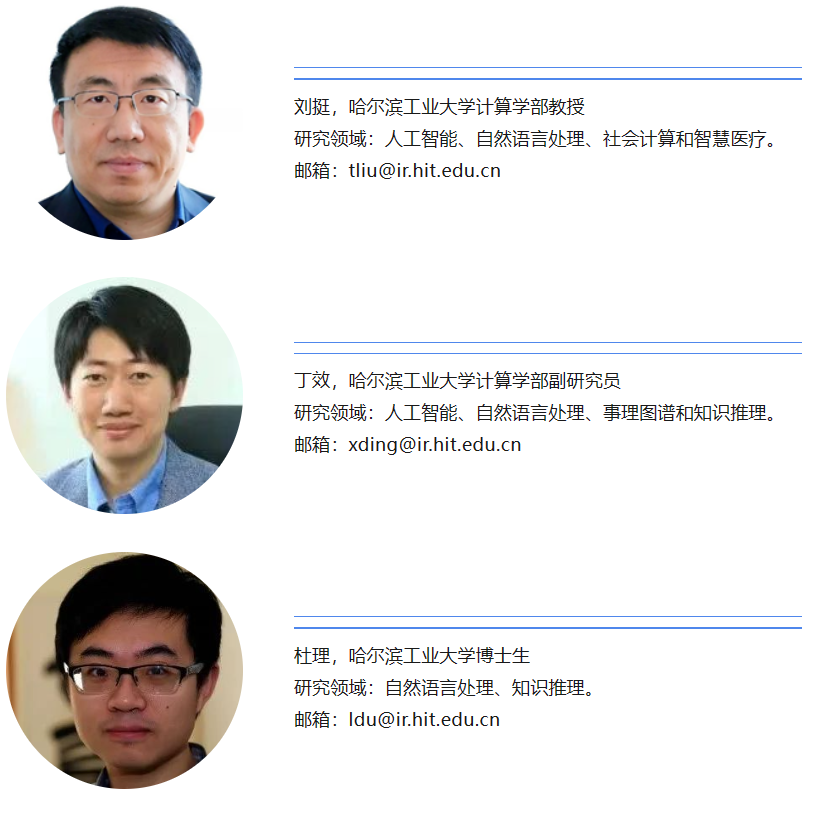开篇导语:
本期发布术语热词:事理图谱(Eventic Graph, EG)。事理图谱本质上是一个事理逻辑知识库。事件之间在时间、空间上相继发生的演化规律和模式是一种十分有价值的事理知识,人类依赖对于这类事理知识的深刻理解来指导日常生活实践,改造客观事物。然而,现有的典型知识图谱主要是以实体及其属性和关系为研究核心,缺乏对事理逻辑这一重要人类知识的刻画。为了弥补这一不足,事理图谱应运而生,它能够揭示事件的演化规律和发展逻辑,刻画和记录人类行为活动。事理图谱对于事件预测、意图挖掘、问答系统、人机交互等上层应用都能够起到很好的辅助作用。
事理图谱
(Eventic Graph, EG)
作者:刘挺、丁效、杜理(哈尔滨工业大学)
InfoBox:
中文名:事理图谱
外文名:Eventic Graph
简写:EG
学科:知识工程
实质:以描述事件演化规律与模式为核心的知识库
基本简介:
事理图谱是一个事理逻辑知识库,描述了事件之间的演化规律和模式。结构上,事理图谱是一个有向有环图,节点代表事件,有向边代表事件之间的时序、因果、条件和上下位等逻辑关系。理论上,事理图谱中的事件是具有一定抽象程度的泛化事件。这些事件可以表示为抽象、语义完备的谓词性词或词组,也可以表示为可变长度的、结构化的(主体,事件词,客体)多元组。
研究背景:
事件是人类社会的核心概念之一,人们的社会活动往往是事件驱动的。事件之间在时间上相继发生的演化规律和模式是一种十分有价值的知识,挖掘这种事理逻辑知识对认识人类行为和社会发展变化规律非常有意义。然而,当前无论是知识图谱还是语义网络等知识库的核心研究对象都不是事件。尽管传统知识图谱在现代搜索引擎中得到了广泛应用,但是其聚焦于实体和实体之间的关系,缺乏对事理逻辑知识的挖掘。事理逻辑知识,包括事件之间的顺承、因果、条件和上下位等关系,对于人工智能领域的多种任务具有非常巨大的价值。对此,事理图谱旨在将事件的演化规律和模式构建成一个有向图形式的知识库,用于刻画和记录事理逻辑。
研究概况:
当前,围绕事理图谱的相关研究主要包含事件抽取、事理图谱构建以及事理知识的表示学习与推理三个主要方面。
事件抽取指从非结构化文本中识别出事件相关元素(如事件触发词、事件论元等)的过程。事件抽取是后续进行图谱构建的基础。根据目标事件范围的不同,可以将现有的事件抽取方法划分为限定域事件抽取[1, 2]及开放域事件抽取[3,4]两类。而根据事件抽取任务的输入文本粒度的不同,可以将事件抽取方法划分为句子级事件抽取[1,2,3,4]及篇章级事件抽取两类[5,6]。
在事件的基础上,前期已有一系列工作旨在将事件组织起来形成知识库,以描述事件间的关系模式。根据所包含事件抽象程度的不同,可分为关注具体事件间关系的事件图[7,8],与旨在描述事件间普遍演化模式,以抽象事件为核心的事理图谱[9,10]。根据所关注事件范围的不同,可将上述知识库分为开放域事理知识库,与关注特定领域,如金融领域等的事理知识库[11]。此外,部分工作构造描述特定种类事件间关系的知识库,如因果关系的事理知识库等[12,13]。
事理知识表示学习的目的是将离散的事理图谱转化为分布式的表示,同时使得表示向量能够一方面保留事件节点的语义信息,另一方面保留事件间关系信息。为获得事件语义表示,一系列前期工作利用词向量组合[14]、张量神经网络[15]等方式,建模事件各个元素之间的语义组合,以得到事件表示向量。为丰富事件语义表示,后期工作亦考虑向事件表示中融入事件背景、事件情感等元素[16]。在事件表示的基础上,考虑到事理图谱中,事件间可能存在的不同的拓扑结构,部分工作分别利用孪生神经网络[14]、循环神经网络[18]、图神经网络[9,18]等结构,建模事件对、事件链与事件间可能存在的密集连接结构,以得到事理知识表示,并服务于后续的推理任务。
事理图谱在未来可针对如下方面进行进一步深入研究:(1)事理图谱的本体论;(2)融合多元知识的多模态事理图谱的构建;(3)时态事理图谱的构建与动态更新;(4)融合事理图谱知识的可解释推理方法。
参考文献:
[1] Liu S, Chen Y, Liu K, et al. Exploiting argument information to improve event detection via supervised attention mechanisms[C]//Proceedings of the 55th Annual Meeting of the Association for Computational Linguistics (Volume 1: Long Papers). 2017: 1789-1798.[2] W. Orr, P. Tadepalli, and X. Fern, ‘‘Event detection with neural networks: A rigorous empirical evaluation,’’ in Proc. Conf. Empirical Methods Natural Lang. Process., 2018, pp. 999–1004.[3] Fader A, Soderland S, Etzioni O. Identifying relations for open information extraction[C]//Proceedings of the 2011 conference on empirical methods in natural language processing. 2011: 1535-1545.[4] Carlson A, Betteridge J, Kisiel B, et al. Toward an architecture for never-ending language learning[C]//Proceedings of the AAAI Conference on Artificial Intelligence. 2010, 24(1).[5] Heng Ji and Ralph Grishman. 2008. Refining Event Extraction through Unsupervised Cross-document Inference[C]. In Proceedings of the 46th Annual Meeting of the Association for Computational Linguistics, pages 254-262. Ohio, USA[6] Zheng S, Cao W, Xu W, et al. Doc2EDAG: An End-to-End Document-level Framework for Chinese Financial Event Extraction[C]//Proceedings of the 2019 Conference on Empirical Methods in Natural Language Processing and the 9th International Joint Conference on Natural Language Processing (EMNLP-IJCNLP). 2019: 337-346.[7] Zhao S, Wang Q, Massung S, et al. Constructing and embedding abstract event causality networks from text snippets[C] // WSDM. 2017 : 335-344.[8] Zhang H, Liu X, Pan H, et al. ASER: A large-scale eventuality knowledge graph[C] // Proceedings of The Web Conference 2020. 2020 : 201-211.[9] Li Z, Ding X, Liu T. Constructing narrative event evolutionary graph for script event prediction[C]//Proceedings of the 27th International Joint Conference on Artificial Intelligence. 2018: 4201-4207.[10] Ding X, Li Z, Liu T, et al. ELG: an event logic graph[J]. arXiv preprint arXiv:1907.08015, 2019.[11] Yang Y, Wei Z, Chen Q, et al. Using external knowledge for financial event prediction based on graph neural networks[C]//Proceedings of the 28th ACM International Conference on Information and Knowledge Management. 2019: 2161-2164.[12] Zhao S, Wang Q, Massung S, et al. Constructing and embedding abstract event causality networks from text snippets[C] // WSDM. 2017 : 335-344.[13] Heindorf S, Scholten Y, Wachsmuth H, et al. CauseNet: Towards a Causality Graph Extracted from the Web[C/OL] // CIKM ’20 : Proceedings of the 29th ACM International Conference on Information amp; Knowledge Management. New York, NY, USA : Association for Computing Machinery, 2020 : 3023–3030. https://doi. org/10.1145/3340531.3412763.[14] Granroth-Wilding M, Clark S. What happens next? event prediction using a compositional neural network model[C]//Proceedings of the AAAI Conference on Artificial Intelligence. 2016, 30(1).[15] Ding X, Zhang Y, Liu T, et al. Deep learning for event-driven stock prediction[C]//Twenty-fourth international joint conference on artificial intelligence. 2015.[16] Ding X, Liao K, Liu T, et al. Event Representation Learning Enhanced with External Commonsense Knowledge[C]//Proceedings of the 2019 Conference on Empirical Methods in Natural Language Processing and the 9th International Joint Conference on Natural Language Processing (EMNLP-IJCNLP). 2019: 4894-4903.[17] Wang Z, Zhang Y, Chang C Y. Integrating order information and event relation for script event prediction[C]//Proceedings of the 2017 Conference on Empirical Methods in Natural Language Processing. 2017: 57-67.[18] Du L, Ding X, Liu T, et al. Learning event graph knowledge for abductive reasoning[C]//Proceedings of the 59th Annual Meeting of the Association for Computational Linguistics and the 11th International Joint Conference on Natural Language Processing (Volume 1: Long Papers). 2021: 5181-5190.计算机术语审定委员会(Committee on Terminology)主要职能为收集、翻译、释义、审定和推荐计算机新词,并在CCF平台上宣传推广。这对厘清学科体系,开展科学研究,并将科学和知识在全社会广泛传播,都具有十分重要的意义。
术语众包平台CCFpedia的建设和持续优化,可以有效推进中国计算机术语的收集、审定、规范和传播工作,同时又能起到各领域规范化标准定制的推广作用。
新版的CCFpedia计算机术语平台(http://term.ccf.org.cn)将术语的编辑运营与浏览使用进行了整合,摒弃老版中跨平台操作的繁琐步骤,在界面可观性上进行了升级,让用户能够简单方便地查阅术语信息。同时,新版平台中引入知识图谱的方式对所有术语数据进行组织,通过图谱多层关联的形式升级了术语浏览的应用形态。
 返回首页
返回首页











